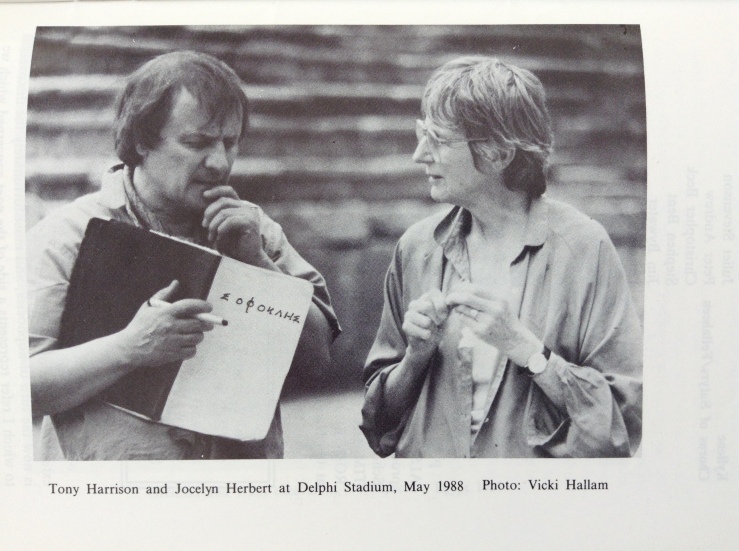
There was an unexpected and moving demonstration of the power of Jocelyn Herbert’s scenography as part of Oliver Taplin’s contribution to the recent conference New Light on Tony Harrison. After speaking about his collaborations and long friendship with Harrison, and how the experience of live performance had changed scholars’ ideas about classical drama, Taplin said that he would have liked to play a recording from the 1988 performance of The Trackers of Oxyrhynchus – if only time had allowed. Members of the audience, their curiosity piqued, called for the recording to be played.
And so Taplin introduced two minutes of sound recorded on 12 July 1988 in the ancient stadium in Delphi. Barrie Rutter, as Silenus, stands alone among twelve wooden packing cases apparently filled with scraps of papyrus found in the rubbish dumps of the city of Oxyrhynchus. He calls for help from the audience in chanting an invocation in Ancient Greek:
ITH-A-GED
PO-DA-VA
A-PA-PAP
O-O-SE-TEE
Taplin explained that the audience of more than 2,000 spectators were ranged at one end of the stadium built to hold 8,000. At this moment in the play, the chant emerged from speakers hidden along the entire length of the stadium, populating the vast space with voices, ‘ghosts of the Pythian Games’ as Harrison calls them. Taplin said of the performance: ‘To say it was site-specific would be an understatement’.
On the recording, as the chant grows, there is a sudden gasp from an audience member, then a half laugh, and then full-throated laughter that spreads through the crowd with added whistles and bursts of applause. The laughter continues for a full minute.
And as the plaster satyrs in the cornice of an elegant room at the British Academy looked down on us, the conference delegates began to laugh too. We laughed at first with gentle amusement, in that slightly puzzled way you do when you can’t exactly see the joke yourself, but are enjoying other people’s delight. But as the recording went on, as the laughter grew and continued, we had time to imagine the scene: the wooden cases cracking open and satyrs climbing out – grotesque figures, with long beards, tails and monstrous erect phalluses. They burst into the present of Delphi, 1988, and then again into London 2017. No wonder we laughed too.
Temporarily denied the visual, my idea of what was happening during the sound recording was of course fed by remembered images, like this photograph by Sandra Lousada. But it was the response of the Delphi audience that came to the fore in this ‘silent’ tribute.
Repeat performances
Tony Harrison has written about how important it was that Trackers of Oxyrhynchus was conceived as a one-off performance:
I have always wanted to prepare a piece for one performance. This was what the ancient dramatists did. In the theatre I most admire, poets, and I stress poets, wrote for actors they knew and for a space they knew. [1]
The Delphi audience had no spoilers, no reviews, no social media teasers to suggest what was about to erupt among them. And it must have been quite extraordinary to be part of the team working so intensely on a performance intended to be unique.
But, in fact, Trackers was subsequently revived.
Among the programmes in the Jocelyn Herbert Archive, there are programmes for the 1988 premiere of Trackers, for a run at the National Theatre, and for a performance in Carnuntum, Austria.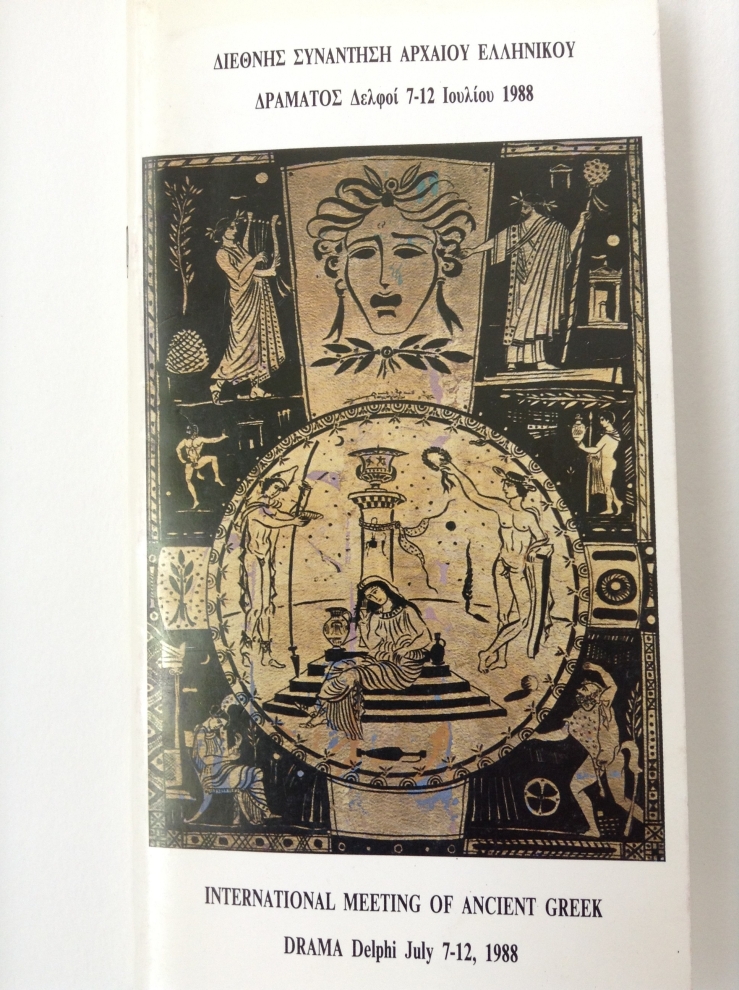
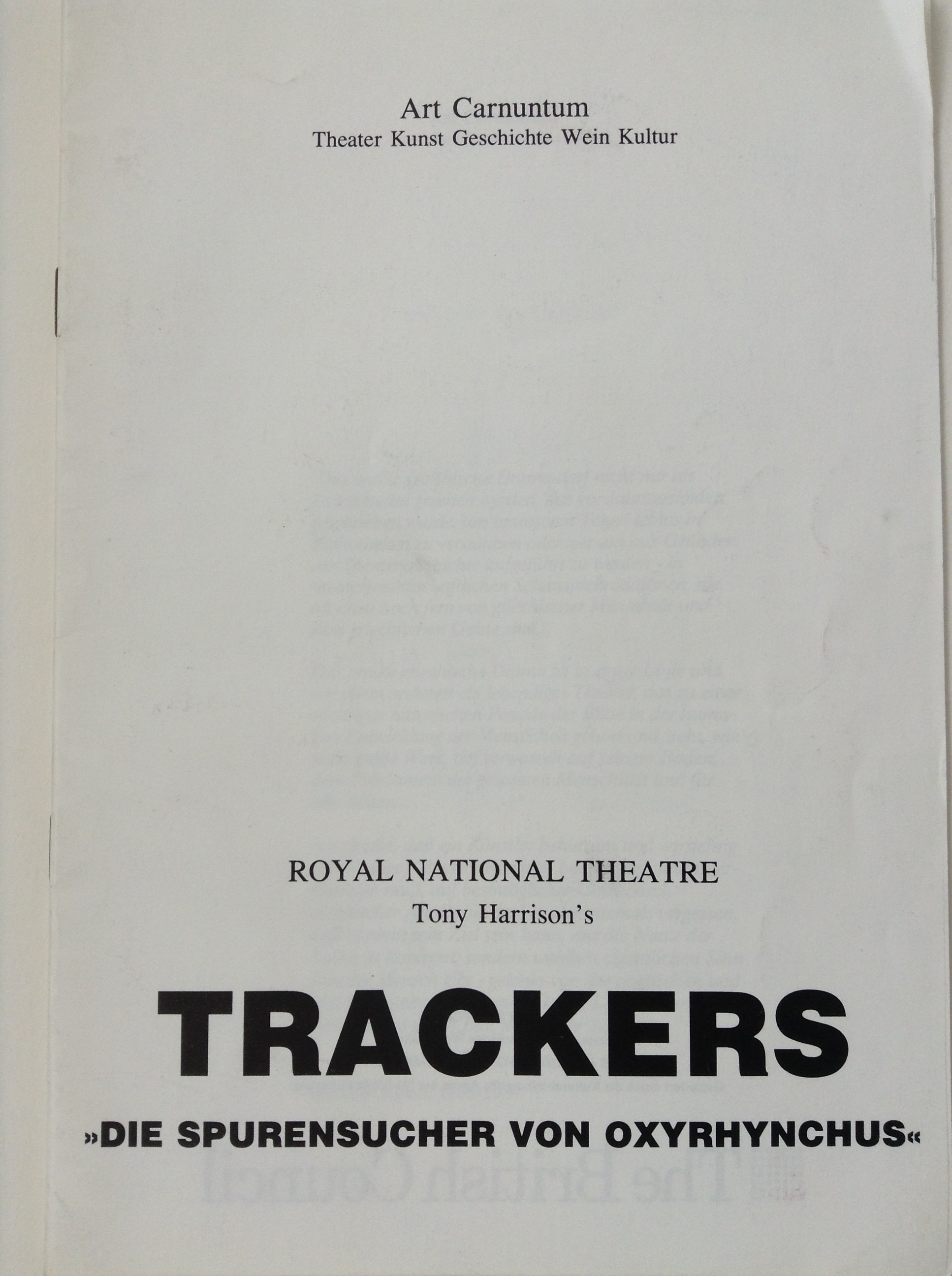
Further information about the play’s brief touring history can be found elsewhere in the main National Theatre archive. After the Delphi premiere, there was another one-off performance (of a revised version of the play) in the Olivier Theatre, on 27 March 1990. This was followed by two short tours: 18 – 21 April at Salts Mill in Saltaire, Yorkshire and 11 – 12 May at Carnuntum, Vienna. The following year, there were 42 performances in the Olivier Theatre, and the play then went on tour to Denmark (Odensee, 18-19 April, and Copenhagen, 22-26 April), and to the Brighton Festival (3-4 May).
The Jocelyn Herbert Archive also includes a programme for a 1998 revival at West Yorkshire Playhouse in association with Northern Broadsides. A note by Barrie Rutter credits the original creative team (including ‘Jocelyn Herbert, Designer and Vicki Hallum [sic], Phallus Maker’) saying they ‘have all added their contributions mightily to this version’. The production photos included in the programme suggest a close resemblance between Adrian Rees’s design and Herbert’s 1988 design, from the costumes of the satyrs to the grid on the floor formed by crates opened flat.
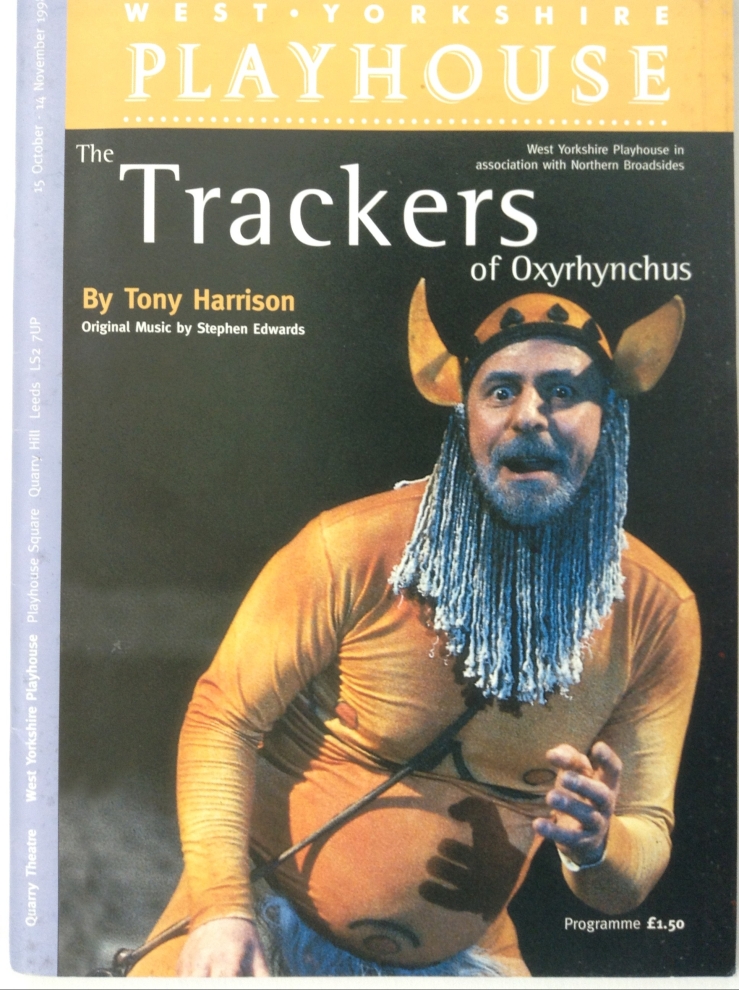
The satyrs, of course, are based on imagery from Ancient Greece, and a description of the set is part of the playtext:
When the chant is loud enough and sparks off its ancient counterpart the crates of the Egyptian Exploration Fund fly open, each containing a satyr. The crates form a grid which is the dancing platform of the satyrs who wear clogs. The insides of the crates are also painted as papyrus and therefore double as tracks of lost words and lost cattle. (National Theatre prompt script RNT/SM/1/325b)
Silenus cuts off the audience’s chant, and in the ensuing silence suddenly the twelve crates stencilled ‘Egypt Exploration Fund’ fall open together revealing in each a SATYR and so forming a CHORUS OF TWELVE SATYRS. The twelve crates open forwards, backwards and sideways and create a labyrinthine platform of crosses on which are painted the tracks of Apollo’s herd. This maze platform is where the SATYRS perform their dance. They wear clogs. These ‘hoofs’ make them the original ‘hoofers’. (published text, pages 29-30)
The collaboration between designer and writer-director on the development and staging of the play is transmuted into printed ‘stage directions’ (although how narrowly or freely to interpret them can be decided by future directors and designers). Jocelyn Herbert said of the way the four sides of the crates fell open: ‘This was entirely Tony’s idea and all I did was to work it out technically’ (quoted in Jocelyn Herbert: A Theatre Workbook, Cathy Courtney, 1993, p.129).
Nearly 30 years later, The Trackers of Oxyrhynchus was revived at the Finborough Theatre, London – a space that could hardly be more different in scale from the Delphi Stadium, holding just 50 people. This review by Liz Gloyn discusses the continuing relevance of questions raised by the play, such as ‘who gets to own classics and who gets to play the lyre’.
‘Plato/used as compost’
After every third play in a group of three tragedies […] would come a satyr play written by the same author, with a chorus of what we can see as men in their animal condition, represented as half or three quarters man with horse or goat attributes and an erect phallus. [2]
The satyr plays – one quarter of of the output of Aeschylus, Sophocles and Euripides – are almost entirely lost to us. Tony Harrison writes that with the loss of the satyr plays, ‘we are lacking important clues to the wholeness of the Greek imagination, and its ability to absorb and yet not be defeated by the tragic.’ [3] The satyr plays went missing, he suggests, partly because of their troubling emphasis on the animal aspect of humanity. The lost satyr play by Sophocles that is brought to life in The Trackers of Oxyrhynchus involves a pack of satyrs imitating dogs on the scent of a herd of stolen cattle.
Harrison’s play is very concerned with material traces, both in terms of their physical existence and their subsequent interpretation. The fragments of papyrus excavated from rubbish dumps at Oxyrhynchus by a team of 30 foremen and 100 workmen under the Egyptologists Grenfell and Hunt, were shipped back to Oxford in crates. One roll of papyrus was apparently tucked into an old biscuit tin (‘Huntley and Palmer’s Best’ according to the an article by PJ Parsons in the West Yorkshire Playhouse programme).
This inevitably reminds me of the way some of Jocelyn Herbert’s model figures are stored in shortbread tins…
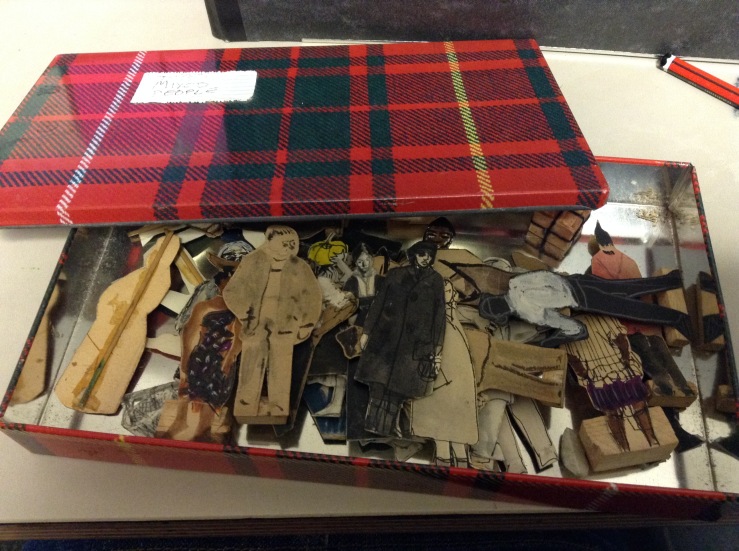
In his 1906 address to the Annual General Meeting of the Egypt Exploration Fund, Dr Grenfell noted how useful the habit of recycling papyrus could be to contemporary scholars: one Pindar text they had found in fragments had been written on the back of a census list: ‘This circumstance is extremely convenient, since it materially assists in assigning small detached fragments to their correct position’ (quoted on p.64 of the Delphi programme JH/13/2).
So in one respect, the practical reuse of material is helpful, but from another point of view, papyrus is just vegetable matter, ready to become compost. Harrison’s Egyptologists complain:
We ship back papyri to decipher them at Queen’s
but they’d use them, if we let them, as compost for their greens.
Bits of Sappho, Sophocles and Plato
used as compost for the carrot and potato! [4]
The satyrs, of course, take this down-to-earth atttitude even further as they track the evidence left by Apollo’s herd:
Sniff, sniff
sniff at the track
we’ve gotta get t’god’s cattle back
[…]
Sniff, sniff
sniff
without stopping
sniff every turd, sniff every dropping [5]
The divisive categories of ‘high’ and ‘low’ that Harrison identifies have not, as Liz Gloyn suggests, disappeared. As a researcher in the archive, I’m drawn to the ‘low’ stuff, the evidence of material practices such as rehearsing stage crews, dealing with weather and solving problems with clogs.
The show reports for the National Theatre performances (mostly written by Company Stage Manager Trish Montemuro) record technical problems with slides and sound; actor’s absences (‘Michael Gregory was back with us this evening. He is now the father of a baby girl, as yet not named but weighing 7/11 at birth’); difficulties in moving and placing the nine crates containing hidden satyrs (an extra costumed crew member helped), and problems with the set: ‘A number of the crates are warping quite badly and really do need attention before tomorrow’s performance. The clogging satyrs are having great difficulty with them and I feel that there could be an injury if they aren’t mended.’
Performing in the open air put the company at the mercy of the weather: in Delphi a heatwave that had made daytime rehearsal impossible was followed by high winds while in Carnuntum, ‘We had two bouts of torrential rain yesterday after everything was set up which meant we had to cancel the technical rehearsal until Friday afternoon. This meant that we couldn’t use local LX crew so everyone took what jobs were necessary to get the show on.’
In Salts Mill, in Leeds, the problem was the cold, and restrictions of the space: ‘Another performance was extremely warmly received with lots of cheering. The only complain [sic] seems to be about not being able to see enough. It’s a pity we weren’t able to get the two levels in as originally planned. Jocelyn and Tony were both pretty peeved about this.’
A show report from 2 April 1990 will send a shiver down the spine of conservationists as it evokes the damage that can be caused by attempts to remove later additions: ‘The crates hadn’t been washed after the last performance so white spirit had to be used to get the graffiti off. A lot of the papyrus painting was removed in the process.’ (All quotations from show reports RNT/SM/2/4/66.)
The repainting of Greek inscriptions on packing crates – like the unending work of repairing sets and replenishing consumable props – evokes the peculiar balance between repetition and change that is inherent in performance. The daily activities of stage management and crew, invisible in most accounts of theatre, chime in this respect with the lost satyr plays, with their emphasis on reproduction and renewal. [6]
It feels more important than ever to think about how these plays contributed to what Harrison calls the ‘wholeness of the Greek imagination, and its ability to absorb and yet not be defeated by the tragic.’
New Light on Tony Harrison was convened by Edith Hall. A Guardian podcast from the event includes comments from playwright Lee Hall and writer Blake Morrison. To hear a recording of the celebration at the Royal Academy, with contributions by Sian Thomas, Richard Eyre and Jasper Britton, go to http://ift.tt/2pgXPNY.
Tony Harrison’s prose is collected in a new volume edited by Edith Hall, The Inky Digit of Defiance: Selected Prose 1966-2016, London: Faber and Faber, 2017.
[1] Tony Harrison (1990) ‘Introduction’, The Trackers of Oxyrhynchus, London: Faber and Faber, p.xx.
[2] ibid., p.x.
[3] ibid., p.xi.
[4] ibid., p.10.
[5] ibid., pp.31-2.
[6] See also the notion of ‘reproductive labour’ which supports the continuation of life rather than producing commodities (e.g. in Maria Mies and Vandana Shiva, Ecofeminism, 1993) and the ‘comic mode’ as a celebration of biological renewal, despite all the reasons for tragic despair (in Joseph Meeker, The Comedy of Survival, 1974).

[…] mask- and prop-maker Vicki Hallam, daughter of Annette Brinkworth, worked with Jocelyn Herbert on The Trackers of Oxyrhynchus. She recalled in an interview that its large papyrus backdrops were painted […]
LikeLike